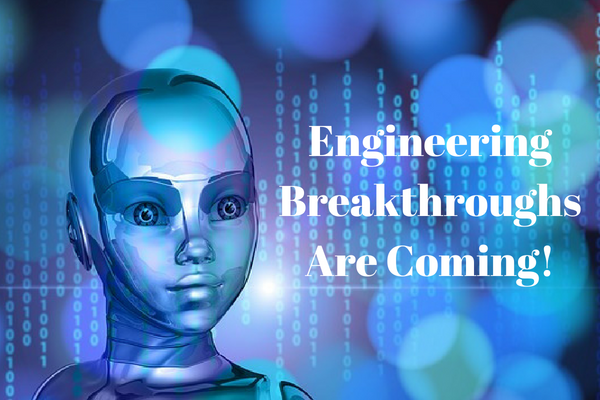
3 Engineering Breakthroughs That Are Set to Completely Change the Way We Live
Read a summary or generate practice questions using the INOMICS AI tool

Some thinkers believe we are approaching a technological singularity where the rate of development will reach an exponential tipping point. A society where technological progress will be made at incredible speeds and we will witness feats of science and engineering only present in an Iain Banks Sci-Fi Novel. This article aims to shine some light on the technologies that have the potential for kick-starting the singularity and booting us headfirst into both an exciting and scary future.
The jobs will be changing too! Click here to inform yourself about 5 exciting new engineering jobs of the future.
1. Graphene
You might be asking, what is graphene exactly? To put it simply, graphene is a one-atom thick blanket of carbon atoms that are arranged in a hexagonal pattern. This is different to Nanotubes and Bucky Balls as this material can be layered (theoretically) into a super strong material that can be used in everyday manufacturing. There are numerous uses for graphene from ultra-efficient transistors to advanced filters for reverse osmosis membranes.
A major part of the reason for the relentless pace of developments in graphene technology is due to the European Union funding initiative for graphene research and development. This 1 billion Euro fund is known as the graphene flagship. Part of the reason for graphene not being a mainstream material is the difficulty to cheaply manufacture graphene for commercial use. Numerous methods have been developed but few show true scalability. However, all it takes is one breakthrough to open the floodgates and before you know it, we could all be driving graphene cars and drinking graphene filtered water.
2. Fusion Power
There is a running joke that net gain fusion power is always 20 years away. This is in part due to massively complex and expensive reactors such as the 23000-ton tokamak machine. Fusion is the process by which two atoms fuse together to form another element. This fusion reaction releases large amounts of energy and has been the holy grail of energy production for decades. The main problem with fusion power is containing the plasma. This is usually done with powerful magnets or lasers. Theoretically, fusion power is possible, just look at the ball of fire in the sky that is our sun. Stars are powered by fusion and thus it should be possible to replicate it on earth. Due to the sheer complexity of fusion power, it will still be some time before we replace our nuclear reactors and coal-fired power plants. However, a net gain fusion reactor will most likely be created within the next 20 years (no, seriously!).
3. Artificial Intelligence
Artificial intelligence, the ‘bogeyman’ of the modern era. We have all seen representations of malicious AI characters in science fiction movies such as HAL 9000 from space odyssey and the terminator. These representations and our response to them indicate a general fear of AI. For the first time in civilized human history, we will not be the most intelligent beings on the planet. Although some manufacturing facilities are already utilising some forms of AI and machine learning, true high-level AI is still a way off. There is still continuous research and development being done on lower level AI that is backed by machine learning and neural network algorithms. These systems absorb terabytes of data about a specific topic and learn through iteration. A computer can run millions of operations in a second and their capacity for simple learning far exceeds that of even the most intelligent humans. A good example of a machine learning algorithm is Googles’ Alpha Go. This system managed to beat the worlds best player of Go, an ancient Chinese board game that’s complexity is far beyond that of chess and requires far more computing complexity to beat a skilled human player. This is because Go players employ an element of creativity and intuition to their play styles and computers cannot just brute force, out compute a human player. Alpha Go may not necessarily employ human-level creative techniques, but it is the first step in intelligent, creative, thinking AI.
Out of all three technologies discussed in this article, AI has the potential to develop at an exponential speed as the algorithms and systems can teach themselves at an incredible rate. AI is coming whether we like it or not, it remains to be seen if the governments of the world will work together to employ effective rules and safeguards to keep AI in check. This is unlikely as the first country to develop true AI will take a giant leap and establish themselves as the next superpower.
Final thoughts
The technologies mentioned in this article are coming, the only uncertainty is when and in what form they will arrive. The question is, will humanity handle these mythical like technologies with responsibility, or use them as tools to enrich and oppress? Only time will tell, and at the rate of current developments, that time is coming sooner than we think.
Looking to boost your engineering career? Take a look at the best Engineering Jobs we are listing now on NewEngineer.com!
Recommended articles
Top 10 US Master's Programs in Mechatronics
Top 5 Aerospace Companies to Work For
10 Jokes Only Engineers Will Find Funny
Five Tips to Nail Your First Engineering Interview
10 iPad Apps Every Engineer Needs
Top 5 Companies for Environmental Engineers to Work For
What are the Benefits of Attending Engineering Conferences?
The 10 Greatest Engineers of all Time
Top 10 UK Master's Programs in Chemical Engineering
5 Ted Talks Every Engineer Needs to Watch
7 of the Greatest Challenges Engineers Will Face in the Next Decade






